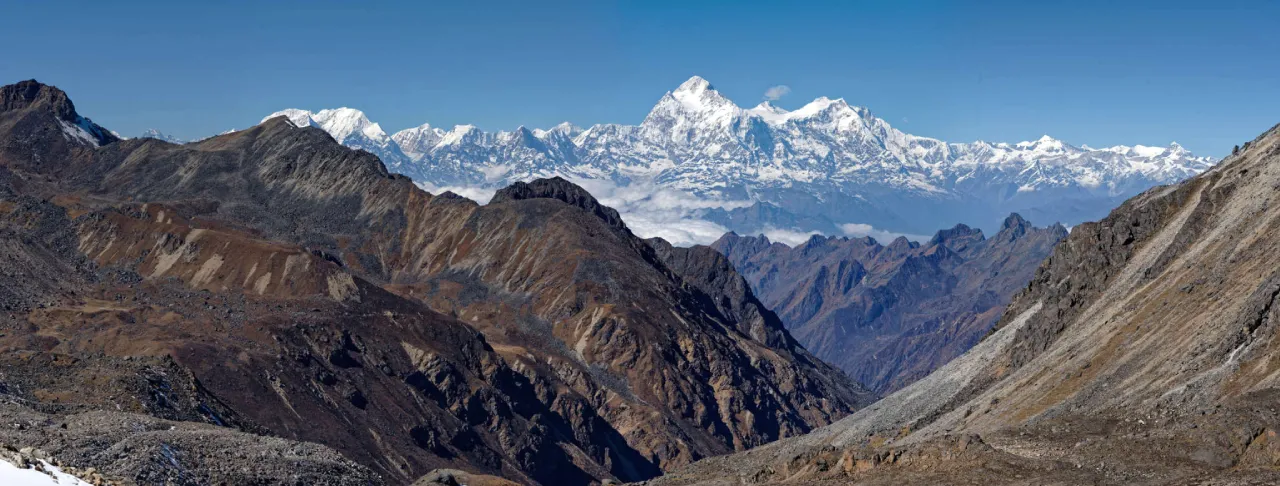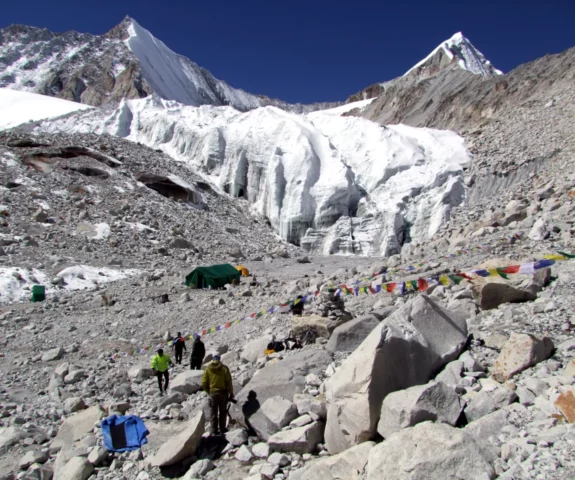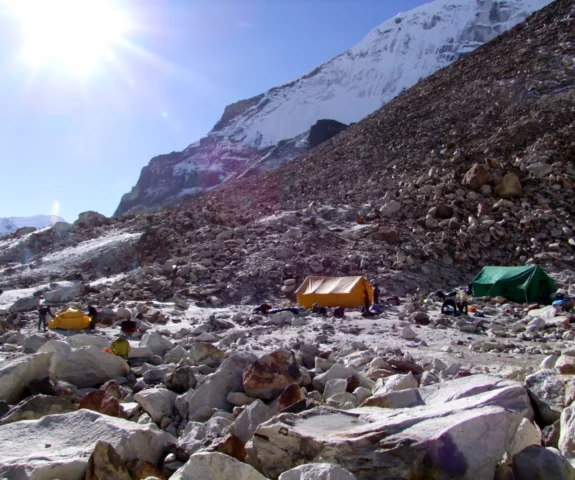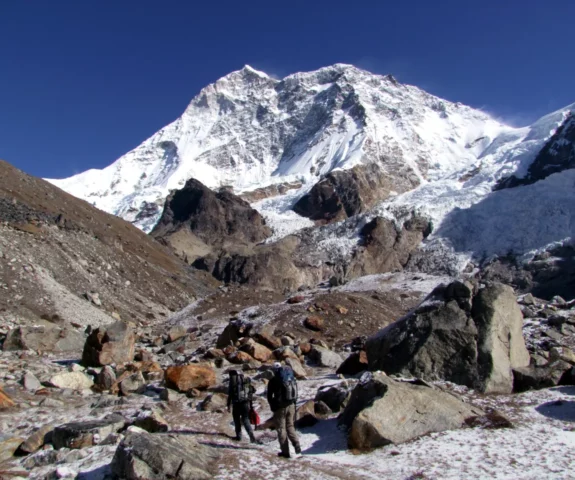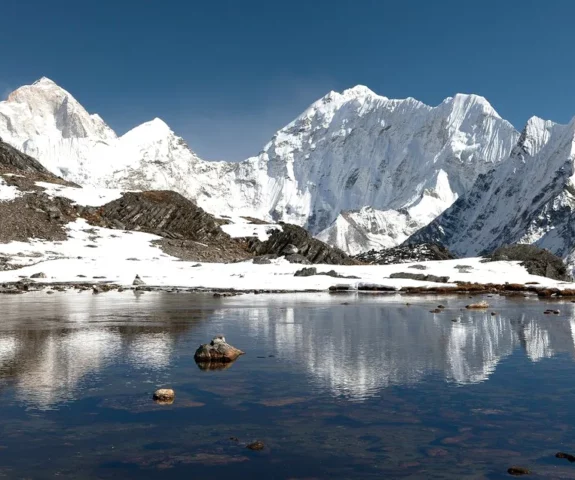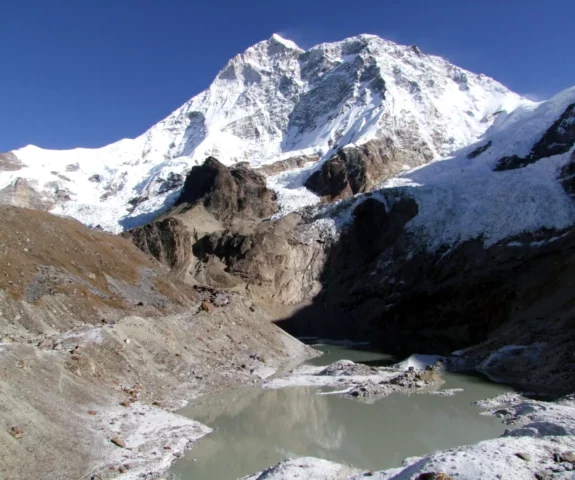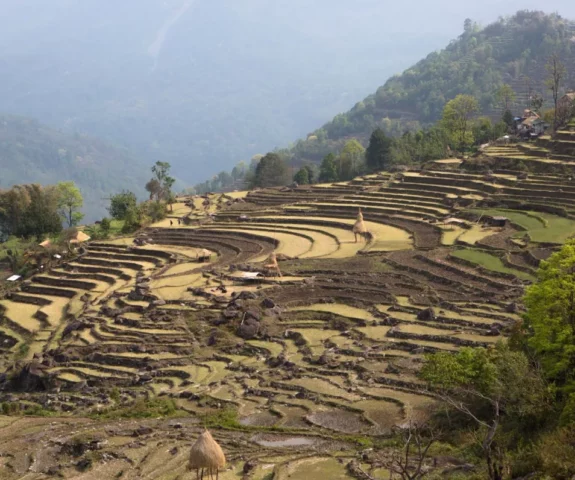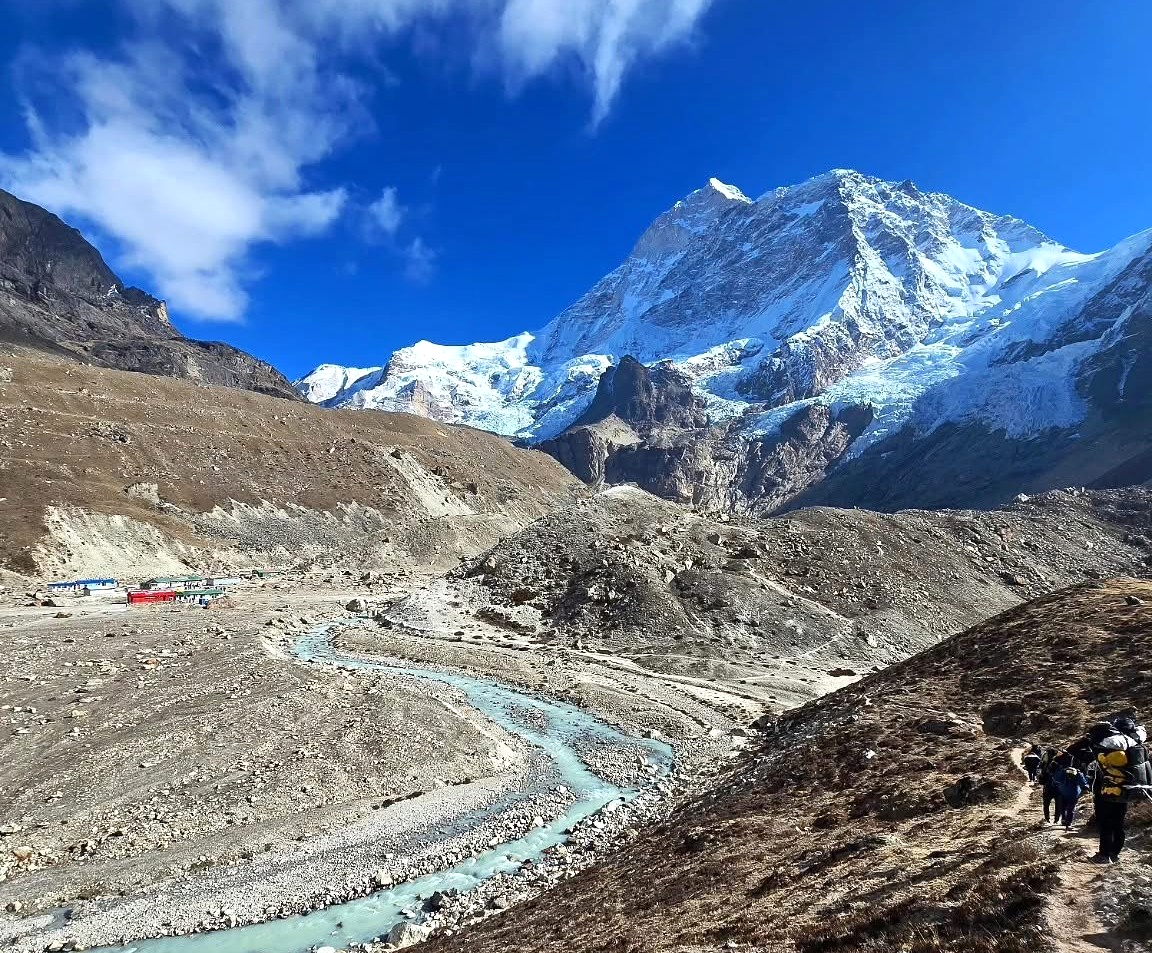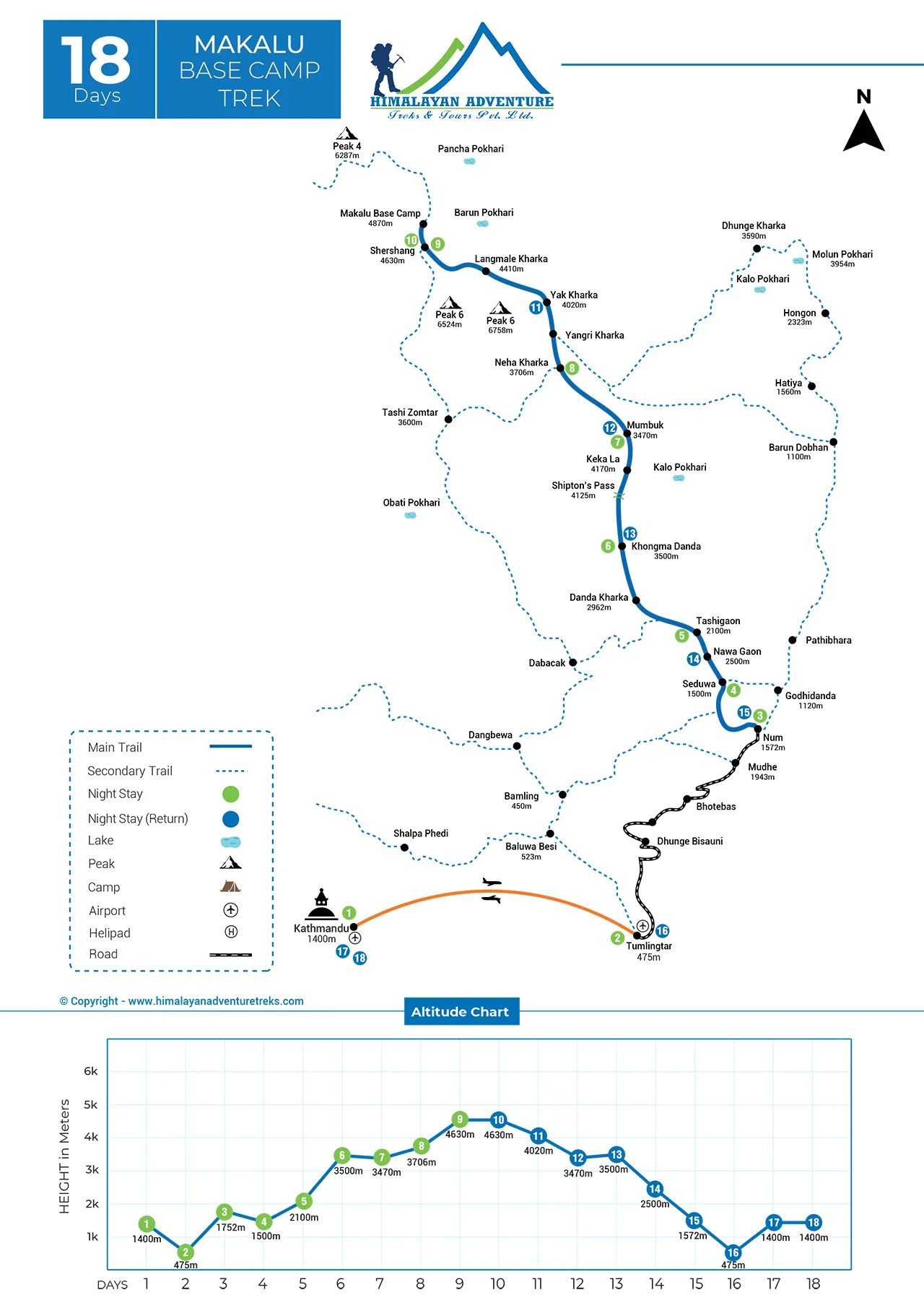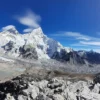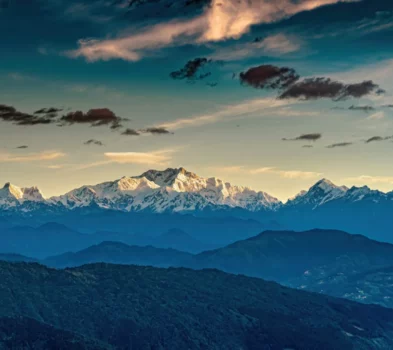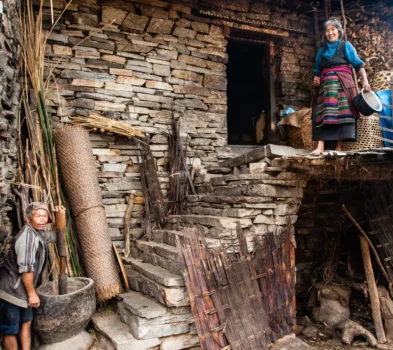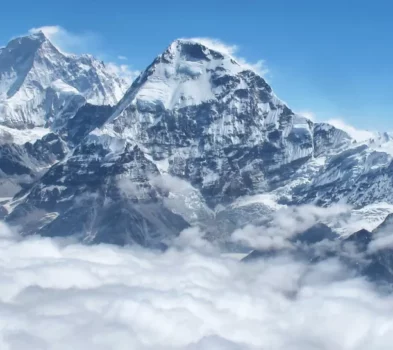Duration
18 DaysMakalu Base Camp Trek
Trip Grade
ModerateGroup Size
1-16 PeopleMax Altitude
5,060m. / 16,601ft.Best Season
Mar- May/ Sept - NovActivity
Trekking and HikingMeals
Breakfast, Lunch & DinnerAccommodation
Hotels & TeahousesTransportation
Private Vehicle & FlightTrip Customization
On request (click here)Highlights of Makalu Base Camp Trek
- Rarely visited gem in Nepal.
- Makalu Base camp including thrilling experience of crossing the high passes and some serene glacial lakes.
- The fifth highest mountain in the world.
- Different types of species habitats.
- The Himalayas including the rare east face of Mt. Everest and Mt. Lhotse.
Trip Introduction
Makalu Base Camp Trek is a rarely visited gem in Nepal. Makalu Barun National Park is the eighth National park in Nepal and was established in 1992, located in the Barun Valley, which is part of a huge international protected area under an agreement between the Nepal and China governments on conservation acts.
The protected area is the habitat for a wide diversity of 3000 species of flowering plants flora and fauna, 440 species of birds, and 75 species of mammals such as orchids, rhododendrons, Musk Deer, Wild Boar, Wild Yak, Snow Leopard, Red Panda, Himalayan Thar, and many more species on the easter part of the country.
The Great Himalaya Trail to Mount Everest from Kanchenjunga is prepared for a combination of cross-country and mountaineering to cross into the upper Barun Valley and then over the high passes of the grueling Makalu Three Cols, which take you up to 6200m high altitude.
Makalu Base Camp Trek is considered by all expeditions that one of the toughest 8000 m Mountains to climb, even the Sir. Edmund Hillary failed twice to climb this Mountain. But the wilderness around it is just waiting to be explored by the intrepid trekker prepared to forgo the comforts of teahouse treks. The camping trail to Makalu Base Camp from the south is considered one of the tougher trekking routes in Nepal.
The Makalu Barun region is known for its heavy rains and snow, so trekking is best done in the autumn months of October and November.
At Himalayan Adventure Treks, we offer a number of services to our clients. We also have professional guides to lead you and make your trip memorable. Also, we have many other trips across the country.
Outline Itinerary of Makalu Base Camp Trek
Day 01: Arrival at Kathmandu Airport.
Day 02: Fly from Kathmandu to Tumlingtar (460 m).
Day 03: Drive from Tumlingtar to Num (1490 m).
Day 04: Trek from Num to Sedua (1460 m).
Day 05: Trek from Sedua to Tashi Gaon (2070 m).
Day 06: Trek from Tashi Gaon to Kohma Danda (3470 m).
Day 07: Trek from Kohma Danda to Mumbuk (3470 m).
Day 08: Trek from Mumbuk to Nhe Kharka (3570 m).
Day 09: Trek from Nhe Kharka to Sherson (4615m).
Day 10: Hike to Makalu Base Camp (5060 m) & return to Sherson.
Day 11: Trek from Sherson to Yak Kharka (3645 m).
Day 12: Trek from Yak Kharka to Mumbuk (3470 m).
Day 13: Trek from Mumbuk to Kohma Danda (3470 m).
Day 14: Trek from Kohma Danda to Nawa Gaon (2500 m) via Tashi Gaon.
Day 15: Trek from Nawa Gaon to Num (1490 m) via Sedua.
Day 16: Drive from Sedua to Tumlingtar.
Day 17: Fly from Tumlingtar to Kathmandu.
Day 18: Departure to Kathmandu Airport.
Our guests sharing their experiences (Photo/Video Gallery)
Detail itinerary of Makalu Base Camp Trek
Day 01: Arrival at Kathmandu Airport.
Your arrival in Kathmandu will be marked by landing at the Tribhuvan International Airport (TIA). A company representative of Himalayan Adventure Treks & Tours will receive you and transfer you to your hotel. Evening you can meet the participants and the trek members. Overnight stay at a hotel in Kathmandu.
Activity: Airport Pickup, 30 min
Max. Altitude: 1,400m/4,593ft. Kathmandu
Accommodation: Hotel
Day 02: Fly from Kathmandu to Tumlingtar (460 m).
In the morning, our guide will pick you up from your hotel to take a flight of an hour to Tumlingtar. The flight to Tumlingtar is scenic as one can see the snow-capped peaks all the way from Langtang to Mt. Everest including Makalu and Kanchenjunga.
On landing at Tumlingtar airport, you will be transferred to lodge at Tumlingtar, a large town located on a shelf above Arun River.
Activity: Flight, 40 min
Max. Altitude: 460m/1,509ft. Tumlingtar
Meal: Breakfast, Lunch & Dinner
Accommodation: Teahouse
Day 03: Drive from Tumlingtar to Num (1490 m).
Enjoying the views of Mt. Manaslu and other mountains in the morning, we head towards Num village. We pass many farmlands and villages as we reach Khandbari. We follow the winding jeep track leading uphill to a village of Chinchilla followed by ups and down to reach Num village.
Activity: Drive, 4-5 hours
Max. Altitude: 1,490m/4,888ft. Num
Meal: Breakfast, Lunch & Dinner
Accommodation: Teahouse
Day 04: Trek from Num to Sedua (1460 m).
The morning starts with the easy trekking to Sedua village. Descending down to the Arun River, we cross the suspension bridge over the river and slowly ascend leaving rainforest behind as we pass some old tea shop, corn & buckwheat field leading to the hamlets of Runruma. Moving along the rocky path and tiny terraces planted with corn and barley, we make a long, steep, rough climb to Sedua.
Activity: Trek, 5-6 hours
Max. Altitude: 1,460m/4,790ft. Sedua
Meal: Breakfast, Lunch & Dinner
Accommodation: Teahouse
Day 05: Trek from Sedua to Tashi Gaon (2070 m).
Today is an easy and short walk to Tashi Gaon, the last human settlement for a week. We start to walk past the Rasuwa River to Gyang (1770m). In the trail, you see many terraced fields and forest areas to Hindrungma village and reach Tashi Gaon.
Activity: Trek, 4 -5 hours
Max. Altitude: 2,070m/6,791ft. Tashi Gaon
Meal: Breakfast, Lunch & Dinner
Accommodation: Teahouse
Day 06: Trek from Tashi Gaon to Kohma Danda (3470 m).
Today is a tiring day as the trail is a long ascent. We slowly ascend to a shepherd’s hut called Chipla atop another ridge and then climb past two small streams, switchback up the ridge in forests to a Kharka. Here, the trail combines with the ridge that separates the Iswa and Kasuwa drainages.
We then slowly climb stone stairs to Dhara Kharka, a meadow atop the ridge. We then move over a hillock and descend to reach Kauma.
Activity: Trek, 5 -6 hours
Max. Altitude: 3,470m/11,385ft. Kohma Danda
Meal: Breakfast, Lunch & Dinner
Accommodation: Teahouse
Day 07: Trek from Kohma Danda to Mumbuk (3470 m).
In the morning, enjoy the panorama view of the mountains. The trail starts with a few ups and downs passing the glacial ponds. On the way, we can witness the famous twin peaks of Chamlang Peak 6 and Peak 7. Later, we climb the stone staircase and climb gently up a shallow rocky gully to the Kike La.
We then cross the Tutu La pass at (4075m) and further continue descending down about 150 meters into dense rhododendron forests to flat land. A short walk past the dense forest leads to the village of Mumbuk.
Activity: Trek, 6 -7 hours
Max. Altitude: 3,470m/11,385ft. Mumbuk
Meal: Breakfast, Lunch & Dinner
Accommodation: Teahouse
Day 08: Trek from Mumbuk to Nhe Kharka (3570 m).
Continuing our journey, we start following the stream and walk along the Barun River to reach Kharka. Moving through forests of birch and scrub rhododendron, we reach Yangle Kharka. After climbing YangleKharka, we cross the north side of the Barun Khola to reach Nhe Kharka.
You can see a small gompa on the south side of the valley that offers great mountain views in all directions.
Activity: Trek, 6-7 hours
Max. Altitude: 3,570m/11,713ft. Nhe Kharka
Meal: Breakfast, Lunch & Dinner
Accommodation: Teahouse
Day 09: Trek from Nhe Kharka to Sherson (4615m).
Today is going to be a very laborious journey as we have to ascend almost 1000 m from NheKharka. We start our trail along the northern bank of the Barun Khola. After a short walk, the trail ascends gently as we approach Ripok Kharka through the huge S-shaped curve that Barun Valley and the walls rise almost vertically 1500 to 2000 meters above the river.
After ascending, we are welcomed by a majestic view of the Pyramid Peak, Peak 4, Chamlang, Peak 3, and Peak 5. Further walking into an alluvial valley you can see the Fifth highest mountain Makalu is visible just before reaching Sherson.
Activity: Trek, 6-7 hours
Max. Altitude: 4,615m/15,141ft. Sherso
Meal: Breakfast, Lunch & Dinner
Accommodation: Teahouse
Day 10: Hike to Makalu Base Camp (5060 m) & return to Sherson.
In the morning, we start our hike to Makalu Base Camp, our highest point of this journey. After a few hours of hike, we reach Makalu Base Camp surrounded by Makalu and Barun mountains with a small glacial pond nearby.
We then climb to the hilltop of the base camp for the rare view of the East face of Mt. Everest, locally known as Khangsung face, and Mt. Lhotse. Later, return to the Sherson and enjoy the surrounding there.
Activity: Hike, 4-5 hours
Max. Altitude: 5,060m/16,601ft. Makalu Base Camp
Meal: Breakfast, Lunch & Dinner
Accommodation: Teahouse
Day 11: Trek from Sherson to Yak Kharka (3645 m).
Wake up early in the morning and enjoy the sunrise view and golden mountain as the rays hit the mountain. Later, we trek back to the very end of the Barun valley at Yak Kharka following the same trail.
Activity: Trek, 6-7 hours
Max. Altitude: 3,645m/11,959ft. Yak Kharka
Meal: Breakfast, Lunch & Dinner
Accommodation: Teahouse
Day 12: Trek from Yak Kharka to Mumbuk (3470 m).
Leaving behind the Barun valley, we make our way as we pass through the forest of pine and rhododendron and reach Mumbuk in the late afternoon to witness the beautiful sunset.
Activity: Trek, 5-6 hours
Max. Altitude: 3,470m/11,385ft. Mumbuk
Meal: Breakfast, Lunch & Dinner
Accommodation: Teahouse
Day 13: Trek from Mumbuk to Kohma Danda (3470 m).
Leaving Mumbuk, we trek across the two passes, Shipton La at around (4040m) and Tutu La- pass, and descend to Kohma Danda.
Activity: Trek, 5 -6 hours
Max. Altitude: 3,470m/11,385ft. Kohma Danda
Meal: Breakfast, Lunch & Dinner
Accommodation: Teahouse
Day 14: Trek from Kohma Danda to Nawa Gaon (2500 m) via Tashi Gaon.
Today, we retrace our way back to the human settlement after being away for a week. We take it slow as we have to make a long descent back through the dense forest to Tashi Gaon. Afterward, we ascend through the cool shades of the trees as we pass through the farmlands and forest to reach Nawa-Gaon.
Activity: Trek, 6 -7 hours
Max. Altitude: 2,500m/8,202ft. Nawa Gaon
Meal: Breakfast, Lunch & Dinner
Accommodation: Teahouse
Day 15: Trek from Nawa Gaon to Num (1490 m) via Sedua.
Getting back to the human settlement after a week, we descent down to Sedua, and then follow the downhill path to the suspension bridge over the mighty Arun River. After crossing the river, we make an hour-long climb to Num village.
Activity: Trek, 6-7 hours
Max. Altitude: 1,490m/4,888ft. Num
Meal: Breakfast, Lunch & Dinner
Accommodation: Teahouse
Day 16: Drive from Sedua to Tumlingtar.
With the wonderful morning views of distant snow-capped mountains, we leave Num and head to Tumlingtar. The drive leads uphill for a while till we reach Chinchilla village. From here, the road is downhill to Tumlingtar passing through the town of Khandbari.
Activity: Drive, 4-5 hours
Max. Altitude: 460m/1,509ft. Tumlingtar
Meal: Breakfast, Lunch & Dinner
Accommodation: Teahouse
Day 17: Fly from Tumlingtar to Kathmandu.
On this day, fly to Kathmandu in the morning. This short and scenic flight possibly makes you feel nostalgic because of the glimpses of snowy mountains through the private window of a plane.
You will be transferred to the hotel where you either have leisure time or you may catch the last moments exploring the sights of Kathmandu. We could take a rest in our hotel room or shop for souvenirs for our Family and friends.
In the evening we will have a farewell dinner at an authentic Nepalese restaurant with a cultural performance.
Activity: Flight, 40 min
Max. Altitude: 1,400m/4,593ft. Kathmandu
Meal: Breakfast & Dinner
Accommodation: Hotel
Day 18: Departure to Kathmandu Airport.
A representative from Himalayan Adventure Treks and Tours will take you to the airport, approximately 3 hours before your scheduled flight. On your way home you’ll have plenty of time to plan your next adventure in the wonderful country of Nepal.
Activity: Airport drop, 30 min
Max. Altitude: 1,400m/4,593ft. Kathmandu Airport
Meal: Breakfast
Note:
If you have your own private group and want to make your trip private, we can run the custom trip all the day as per your requirements and group size.
Includes and Excludes
What are included with package?
- Pick up from Airport and Transfer to the Hotel: Upon your arrival at the airport, you will be picked up and transferred to your hotel in Kathmandu.
- Two Nights 3-star Hotel in Kathmandu with Breakfast: Enjoy a comfortable stay for two nights at a 3-star hotel in Kathmandu, including breakfast.
- Lunch, Dinner, and Breakfast During Trekking: All meals (lunch, dinner, and breakfast) are provided during the trekking portion of your trip.
- National Park Permit: The permit required to enter and trek in the national park is included in the package.
- Trekkers’ Information Management System (TIMS) Permit: Your TIMS permit, which is required for trekking in Nepal, is included.
- All Necessary Paperwork: All the necessary documentation, permits, and paperwork for the trek will be provided.
- Domestic Airport Picks Up and Drops by Private Vehicle: Private transportation will be provided for pickups and drops at the domestic airport.
- Flight Ticket Kathmandu/Tumlingtar/Kathmandu and Domestic Airport Tax: The flight from Kathmandu to Tumlingtar and back, along with any applicable domestic airport taxes, are included.
- All Accommodations in Tea Houses During the Treks: All accommodations during the trek will be in comfortable lodges or tea houses.
- An Experienced, Helpful, and Friendly Guide, Porter (1 Porter for 2 Clients): An experienced guide will accompany you throughout the trek, along with a porter to carry your bags (1 porter for every two clients).
- Travel and Rescue Arrangements: Travel and rescue arrangements will be made if necessary, ensuring your safety throughout the trip.
- Medical Supplies (First Aid Kit): A first aid kit will be available with your guide in case of any minor injuries or health issues.
- Last Night’s Farewell Dinner at an Authentic Nepalese Restaurant with a Cultural Performance: On the last night of your trek, you will enjoy a farewell dinner at a traditional Nepalese restaurant, accompanied by a cultural performance to celebrate the completion of your journey.
What are not included with package?
- Nepal Visa Fee: You can easily obtain your visa upon arrival at Kathmandu airport. The visa fee is not included in the package.
- International Airfare to and from Kathmandu: The cost of international flights to and from Nepal is not included. You will need to arrange and pay for this separately.
- Extra Night Hotel Accommodation in Kathmandu: If you arrive early, depart late, or return earlier than the scheduled itinerary due to any unforeseen circumstances, such as weather delays, you will need to pay for any extra nights of accommodation in Kathmandu.
- All Meals in Kathmandu: Meals in Kathmandu, including lunch and dinner, are not included, unless there is an early return from the mountain that deviates from the scheduled itinerary.
- Additional Expenses in the Mountain: Unexpected expenses that arise during the trek, such as delays due to bad weather, flight cancellations, or other circumstances, will be at your own cost. This may include extra accommodation, meals, or transportation.
- Travel and Rescue Insurance: You are responsible for obtaining your own travel and rescue insurance, which covers emergency evacuation, medical expenses, and any other travel-related issues.
- Personal Expenses: Any personal costs such as phone calls, laundry, bar bills, battery recharges, extra porters, bottled or boiled water, hot showers, or any other personal purchases will not be covered and are your responsibility.
Pick Your Suitable Date
Book a Private Trip
Private & Group Discount Price
-
1 -
1 person
US$ 4000
-
2 -
2 people
US$ 3500
-
3 -
5 people
US$ 3300
-
6 -
10 people
US$ 3200
-
11 + people
9999
US$ 3000
Total Cost:
US$ 4000
Route Map & Altitude Chart
Kathmandu
Start/End point
Kathmandu
Trip Information
Physical Fitness:
Many people have questions as to what level of physical fitness is required for trekking in Nepal and that is extremely reliant on what activity the visitor is engaging in Nepal With that said, for a standard easy trek to Extreme hard level of trekking. The daily activity (trek) would be 5-6 hours,(depend on the trekking trail) and elevation will generally not exceed 5,600 meters like Everest Base Camp, Throng la passes, Chola passes treks and other passes or Base Camp but some of them are less than 4000m.
The trekking day is involving both long steep climbs, and descents with a variety of terrain underfoot from well-trodden paths, to rocks covered with ice or snow, depending on the season. Mostly a day would include a number of climbs or descents of 600 meters more or less, starting after the early morning breakfast, resting at a lunch place in the afternoon, then continuous trekking until arriving at the teahouse.
In preparation for the trekking in Nepal, it is important, to begin with, the basic training requirement at least 2 months before departing for trekking in Nepal. Two to three hours of aerobic exercise like running, walking, swimming, cycling & some gym work per week is the minimum and most will find it beneficial to add some basic strength training to their physical fitness routine required for the hard trekking and for normal and easy trek just have some physical fitness is enough.
One of the best ways to prepare is to take practice hikes with a daypack roughly the same weight as what you will be taking during the trek. Your calf should be enough fit and prepare for trekking. Mostly during the trekking calf pain or tiredness is the main issue. Do this only after a baseline of fitness has been reached. Moving fast is not our goal, will provide a more enjoyable and safe adventure trekking in Nepal for all easy and hard level.
Trekking Seasons in Nepal:
There are main two seasons in which Nepal where the most amount of visitors visit. (September, October & November) being the most popular season which is also called the peak season in Nepal, and spring (March, April & May) coming in close behind which is also called the mini-season in Nepal. The summer months of June, July, and August are the monsoon season and most of the time raining as such the trails are mostly washed out sometimes, and roads can sometimes be impassible due to landslide activates. Nevertheless, you can trek to rain-shadow regions like Upper Dolpo and Upper Mustang during the monsoon seasons. Nepal is a suitable destination for all seasons.
Winter is very dry & extremely cold and all the high passes become inaccessible due to ice and snow conditions. The temperature doesn’t usually fluctuate during the day time temperature is around 20-25 degrees. However, you gain altitude the temperature decreases. The temperature can drop to around 0 to -25 degrees at night when staying at tented camps in Himalayan regions. Winter trek in higher altitudes is not advised due to the danger of avalanches and also altitude sickness. Although some may enjoy the sight of the snow-covered mountains as you reach your destination. However, the temperature does not change as much in lower mountain regions the nights are slightly colder than days’ time.
Autumn &Spring is the best timing for trekking in Nepal because the weather is generally warm and dry, and flowers are in bloom in the lower elevations of the country on the same time you can see the many festivals during that period.
Trekking Day:
A typical trekking day begins with the early morning breakfast around 7 am in the hotel. (Depend on the trekking region). It would advise you to pack your trekking gears in a duffle bag and essential supplies in your day pack after having breakfast; we begin the trek and head along the trail at around 8 am. The morning walk is more energetic to be longer as we begin with refreshed bodies and enthusiasm. A good morning’s walk, we make a stop for lunch at around 11-12 pm. The lunch involves group meals enjoying the vicinity around the stop & enjoys the organic & local food in the mountain.
After resting for about an hour or two, we resume our trek to reach the teahouse or camp by 2-3 pm. The afternoon walk is relatively shorter and can involve games and side trips as organized by the trekking experienced guides. You also can enjoy breaks during the trek to relax, read, and stroll around the area, or doing yoga. You can explore with the local people and observe their lifestyle & culture. Dinner is served around 7-8 in the evening to round off the day.
Meals and Accommodations:
During the trekking period, the accommodation is commonly referred to as teahouses. These are family-run basic lodges that fill the role of the restaurant, Dining hall, and boarding house for tourists. Now a day’s electricity can be found in the rooms, which means one light bulb, and one or two outlets for charging electronics. The common areas are also lit by electricity. Alternatively, teahouses may also use solar, hydroelectric, or have electrical lines running into the village, so the commonality and availability of electricity may vary. Still, a few of the trekking route electricity service is not available. Use the local traditional kerosene light.
Most of the teahouses have private rooms, though if the trek is in a more remote or high altitude place there are limited teahouses so season time dormitories are the norm. Most of the room has 2 single beds with basic bedding, and the bathroom is shared. Some of the places we can get the private bathroom also with a mix of western and squat style toilets in the bathrooms.
Breakfast and dinner are taken at the same teahouses and these lodges have large family-style dining rooms centered on a stove or coal to provide heat basically in mountain areas. Most of the area’s menu will have Nepali-style western foods such as pancakes, pizza, burgers, fries, etc. Also on the menu is the traditional Nepali food Dal Bhat meal. This is a lentil soup with rice, vegetable, Pickle, or meat curry. Most menus will also offer a smattering of local cuisine.
Internal Flight Delays:
Nepal is an incredible and beautiful country of mixed of the White Mountains, deep valleys, Landscape, rivers, and green rolling hills. With this incredible diversity of landscapes, road travel can be extremely time-consuming and flights within Nepal to reach popular trekking destinations is the easiest way. Not all the trekking destination has flight service so road transportation is the only option. Mountainous terrain also comes with the possibility of in-climate weather. It mentions the incredibly high number of visitors during peak seasons makes internal flight delays a genuine possibility.
To manage this situation it may be helpful to have a few extras days on either end of your tour. If any cancellations or flight delays do occur (high chances of flight delays from around Kathmandu to Lukla, Everest region, Pokhara to Jomsom, Annapurna region), we also provide services to arrange chopper on the last stage to help you to be on your schedule on the premises of Civil Aviation Rules in Nepal which state that helicopters can fly if the visibility is 1500m. The cost ranges from USD400 to USD650 according to the number of passengers.
The payment can be made either to the helicopter company or to us directly and can be made either by cash or using a credit card. It will be very helpful to purchase and review your insurance as some of the alternative measures for travel may be covered by the insurance companies. Flight insurance may cover changing your international flight if it is necessary.
Travel Insurance:
Most expeditions, Adventurous trekking, and tours require that travel insurance and it is purchased prior to arriving in Nepal, but other normal treks and tours may not require. However, travel insurance is definitely an important consideration. There are a number of reasons to consider insurance. Firstly, it may be required, so check to see what is being asked for by the company. Second, Nepal is a landlocked country, and there are only a few direct flights.
Travel in and out of the country can encounter some disruptions if purchasing insurance, make sure flight delays and cancellations also included. Always choose insurance that, though every safeguard is in place during your Holiday, there are always extenuating circumstances that may result in an accident during trekking & tours. Read carefully printout of insurance policies to ensure that the trekking or any other activity you are engaging in is covered or not, as some policies have stopped covering trekking in certain places.
If you are going above 5000 m or high always mention the policies so it’s cover the chopper service in the last condition. It is very important that if you have the comfort of good insurance, so do the research and choose carefully which makes your trip relaxing and joyful.
Nepal Visa Entry Procedure:
There is only one International airport which is the Tribhuvan International Airport in Nepal. Immigration Office, TIA (Tribhuvan International Airport) under the Department of Immigration has been facilitating tourists flying to Nepal by providing visas on Arrival.
‘On Arrival’ visa procedure is very quick and simple. October, November, March, April can expect some queues during peak Tourist season and October is basically the Nepalese got the Main festival Dashain. You can also get Visa from Nepalese Diplomatic Missions stationed abroad prior to your arrival. The choice is yours.
Visa obtains from Nepalese Diplomatic Missions, and then you must enter Nepal within six months from the visa issued date. Your total stay is counted starting from the day you enter Nepal.
Visas obtained on Arrival at the Entry and Exit points are ‘Tourist Visas’. They bear multiple Re entry facilities. Tourist Visa ‘On Arrival’ is the only entry visa to Nepal. If you are visiting Nepal for purposes other than Tourism (sightseeing, tour, travel, mountaineering, trekking, visiting friends and families), you should still get a ‘Tourist Visa’ to get into the country. However, you must change the category of visa as per your purpose and length of stay in Nepal from the Department of Immigration by producing the required documents.
Please click below for the online Visa form.
http://online.nepalimmigration.gov.np/tourist-visa
The following visa rules apply for tourists:
- For 15 days Multiple Entry Visa, the visa fee US $ 30 or equivalent foreign currency.
- For 30 days Multiple Entry Visa, the visa fee US $ 40 or equivalent foreign currency.
- For 100 days Multiple Entry Visa, the visa fee is US $ 100 or equivalent foreign currency.
According to the immigration regulations, a tourist is allowed to stay in Nepal only for 150 days a year. You can extend the visa up to another 90 days.
US$ 2 or equivalent Nepalese currency per day for extension.
Additional US$ 25 or equivalent Nepalese currency on visa fee, if Multiple Entry facility is required for the extended period
For more details please visit our FAQ link
https://www.himalayanadventuretreks.com/faq/
Acute Mountain Sickness (AMS):
Acute Mountain Sickness (AMS) is usually seen in un-acclimatized people shortly after ascent to high altitudes. The condition occurs due to the thinning of air as the altitude increases. The condition, if not taken seriously and treated immediately, can be life-threatening and its symptoms can be seen generally above 3200 meters. The symptoms of Acute Mountain Sickness are nausea, vomiting, tiredness, shortness of breath, and cerebral pain.
The itineraries are designed to properly acclimatize you to the change in high altitude climate and sufficient precautionary measures too are taken to take utmost caution for our valuable guests. Our staff also equipped with cell phones and satellite phones (Option) in the occurrence of any emergency cases. We are greatly driven to keep the safety and security of our clients as our foremost concern.
Drinking-Water:
Water is essential for life, and clean water is imperative while on holiday. When visiting less developed countries like Nepal, it is a concern that all travelers should consider. There are few options when trekking or traveling in Nepal that will mitigate any chances of drinking contaminated water. The first consideration to take into account is that tap water should not be ingested.
That even means when brushing your teeth in an urban area. Most will choose to buy bottled water and if doing so make sure the cap has sealed properly. Plastic bottle reuse is a big problem, and with that being said there are other options on the market to assist in making water drinkable. Mountain spring water is drinkable but if you use the purified tablet. The conservation area project also sells this tablet for most of the trekking area. A guide will assist you in finding out about it.
Arrival Instruction:
Upon your arrival at Tribhuvan International Airport (TIA) Kathmandu Nepal, our company representatives are stationed to welcome you to the country. We request you to carefully look for your and company name placard being held by our representatives following the events upon landing. Our representatives will be responsible to escort you up to your hotel in Kathmandu. There are many brokers, Taxi drivers, and trouble maker people offering you to carry your luggage and take you to your destination as you exit from the gate. We request you to pay no attention to these people and follow the company representatives and follow their instructions.
How to Book Your Tour:
Before booking any tour or trekking please read all the terms and conditions thoroughly and call or email the company representative with any questions prior to making any payments. Begin by filling out a booking form and pay the non-refundable deposit. Fill out the form completely and if any confusion contacts the company person so as not to disrupt the expediency of the process. The form may be submitted online or by downloading the form and mailing or Whatsapp the form to your company representative.
It is very important to understand all aspects of the chosen trip, from what’s included and excluded, to the level of service, or even what trip may be right for your level of experience and fitness. Take the time to get all the questions answered so that when booking the trip, it is without trepidation.\
Equipment List for Makalu Base Camp Trek:
Makalu Base Camp Trek is difficult trekking but however our long-year experience of operating Trekking to Nepal, We learn many things and would like to give some information to pack your equipment list for your Makalu Base Camp Trek and we hope, this information will be helpful you so success your trip.
Luggage/Duffle bag:
You will require a duffel bag or a backpack for trekking (65- 75 L) max and all our trekking stuff is kept in this duffle bag and this will be carried by our porters. However, Himalayan Adventure also provides the duffle back if needed.
A day backpack:
You will need a day backpack and you will be carrying it every day by yourself and we recommend you it has to be at least 25L and you can carry important documents like Passport, credit card along with a need to carry a water bottle, snacks bar and clothing layers (hat, gloves, fleece, sunblock, poles, etc…).
Trekking/Hiking boots:
Makalu Base Camp Trek is difficult to trek and It is very important to have good trekking boots and it should be waterproof (in case of snow, or rain) Make sure it should be fit on your feet and comfortable during walking. Also, recommend you bring the Crompton during the winter season in Nepal.
Sport Sandals:
You need to have a pair of sports shoes or sandals to use while you are in camp or tea houses after the trek.
Sneakers:
Makalu Base Camp Trek is difficult trekking so sneakers are not suitable for this trek so you can leave your sneakers in the Kathmandu hotel until you get back.
Sleeping Bag:
You need to have a lightweight sleeping bag that works for minus 15 degrees for the summer season but during the winter we recommend minus 20 degrees for the Makalu Base Camp Trek. Himalayan Adventure can provide it if you need one but has to be returned after the trek.
Fleece jacket:
You need to have good quality fleece jacket at least 1 synthetic jacket or pullovers are a great alternative to fleece because they are lighter and more compressible and gives you enough warmth during trekking.
Down jacket:
A Down jacket is compulsory and recommends you bring warm enough so can keep you warm during the Makalu Base Camp Trek.
Socks:
You need to have at least 6 pairs of thick socks during the spring & autumn but winter and monsoon need at least 8 pairs of socks for the Makalu Base Camp Trek.
Lightweight/ warm insulated pants:
You need to have at least 4 pairs of lightweight trekking pants like Lightweight expedition thermal bottoms, Nylon hiking shorts, Softshell and hardshell trekking pants, Water/windproof trousers, and Casual pants so we can use them like the weather.
Short-sleeved shirts:
You need to have 4 ice-breaker merino wool to keep you warm from the cold or synthetic shirts and if you are not allergic to wool products, merino wool is the ideal for Makalu Base Camp Trek.
Long-sleeved shirts:
You need to have at least three shirts.
Underwear:
You need to have few pairs of underwear and this can be as much as you need as there are no washing facilities every day on Makalu Barun Trek, we highly recommend you to have enough pair of underwear.
Waterproof jacket:
You need at least one waterproof jacket for the rain/snow and wind for the Makalu Base Camp Trek and waterproof pants may be an option.
Head and face gear:
Sun Hat or cap during the daytime, Woolen Hat for morning & Evening, and Polarized sunglasses are compulsory.
Hand gear:
You need warm gloves.
Traveling supplies:
Adapter Plug for Charging the Camera and Mobile, Camera belt, Passport belt ( nice to have), Swiss army knife (option), Flashlight, Headlamp, Water bottle, Extra camera battery, Hand sanitizer, Alarm clock, Hiking poles (optional ), and Binoculars (optional).
Toiletries:
Razor, razor blades, shaving cream, aftershave toothbrush, toothpaste, dental floss, sunscreen, toilet paper, small towel, and period pads (for women).
Medication:
First Aid Medical Kit box (can be purchased in Thamel Kathmandu), Altitude Medicines (Diamox), Tylenol, aspirin, ibuprofen, Anti-diarrheic, Powerful antibiotics, and Nasal Spray or Drops.
Essential Packing Gear List for Makalu Base Camp Trek
If you have decided to go on the hidden gems trek, Makalu Base Camp Trek in Nepal, we assure you that you will have a fantastic time ahead. But what should you pack for your Adventure? What will be the right gear to make your trip more fabulous? To help you with this, we have compiled a packing list of essential items that you mustn’t forget to bring along.
- Passport ( min 6 months valid)
- Cash, credit card
- List of important addresses and contact details
- 2-3 passport photos (optional)
- Copies of all important travel documents (passport, visa, airline ticket, insurance policy, etc.)
- A sturdy 70 L trekking backpack which will be carried by your porter (please note that our assigned 1 porter will carry 2 clients’ luggage up to 20-25 kg.
Note: We will provide each participant with a spacious 70 to 75 L Company logo duffle bag to conveniently carry your trekking gear, which you have to return once the trek is complete. - A 30 L Daypack that has room for your essentials such as camera, mobile, Passport, important documents, water bottle, day-useable medicine, chocolate bars, raincoat, etc., which will be carried by you.
- Protective cover for a backpack or travel bag.
- Hiking Boots: Preferably ankle-high boots to prevent ankle sprain
- Regular Shoes: For small strolls and exploration around the city
- Crampons: During the winter, December- March
- Second, a light pair of shoes and possibly sandals
- Micro Spikes or Ice Cleats for the winter trekking over snow and ice
- Gaiter for added protection in snow
- A rain and wind-resistant, lightweight down jacket for warmth, with a good helmet hood
- Summer-light, as well as winter warm clothing
- Quick-drying shirts made of synthetic fabrics
- Warm and cool vests or T-shirts
- Functional synthetic underwear
- Sports Bra for Female Trekker
- A waterproof pair of trousers
- Regular trousers of quick-drying fabric
- Hiking shorts
- Cargo Pants with multiple pockets to hold your small items, such as knives or chocolates
- Woolen or fleece pants
- Trekking socks, both thick and woolen fabric, and lighter wool socks
- Wool hat, gloves, and scarf
- A light cotton scarf or a bandanna for protection of your head, neck, ears, and mouth
- Sun hat, and sunglasses with 100% UV protection (for trekking trips, even with stray light and nose protection)
- Sunscreen cream or lotion with a high sun protection factor (at least 15, for trekking trip,s even at least 30)
- Sunscreen lipstick with a high SPF (at least 20, for trekking trips, even at least 30 or sunblock)
- Mosquito repellent (Optional)
- Comfortable light night clothes and shoes
- A drinking bottle that can be used as a hot water bottle on frosty nights
- Flip-flops or bathing shoes for using the showers
- Water purifiers: if you need to refill water from the tap or stream en route
- Headlamp: for a midnight or pre-dawn trip towards the viewpoint
- Quick-drying towel and sample-size toiletries for washing your feet and face
- Your Personal first-aid kit: with basic medical supplies such as bandages for sprains, antidiarrheal and antibiotics, iodine wipes for scrapes and cuts, plasters, aspirin, or ibuprofen, moleskine for preventing blisters, Diamox (acclimatizing medicine), and your Personal medication
- Sleeping bag appropriate for all-season treks (we can hire in Kathmandu)
- Waterproof money belt, chest bag, leg bag, or belt bag for storing important travel documents or valuables
- Toothpaste, Toothbrush, and soap
- Deodorants
- Moisturizer
- Nail clippers
- Feminine hygiene products (Sanitary Pads)
- Small mirror
- Wet wipes
- Hand sanitizer
- Comb
- Camera with sufficient memory cards and spare batteries or battery charger
- Small padlock for your travel bag
- Crampons ( during winter, Dec- Feb)
- Thermos flask
- Water bag
- Toilet paper (2-3 rolls without)
- Ear Plugs
- Matchbox, or lighter
- Compass or GPS
- Map
- Alarm clock
- Multi-tool kit
- Binoculars
- Books
- Whistle
Equipment Note:
- Please note that there is no need for you to bring all these heavy items, such as a Sleeping bag, a down Jacket, Trekking Poles, and items from your home. You can easily rent or purchase high-quality to standard-quality items in Kathmandu.
- Items are available from international brands such as The North Face, Sherpa Adventure, Marmot, Mountain Hardware, Black Yak, Karma Gear, and local brands like Goldstar and locally made products etc.
- Plus, we will also gift you a company logo T-shirt as a token of your experience in Nepal with us.
Renting Cost:
- Sleeping Bag & Down Jacket (-10-20 degree Celsius), Per Piece per day US$ 1.5
Frequently Asked Questions
What is the Makalu Base Camp Trek?
The Makalu Base Camp Trek is a remote and challenging trek in eastern Nepal, taking you through the pristine wilderness of Makalu Barun National Park to the base of Mount Makalu (8,481m), the fifth-highest mountain in the world. This trek is ideal for those seeking a less-traveled and raw Himalayan adventure.
Where is Makalu Base Camp located?
Makalu Base Camp lies in the Barun Valley, within Makalu Barun National Park, situated in the Sankhuwasabha District of eastern Nepal. It is part of the Greater Himalaya Trail and lies close to the border with Tibet, China.
How difficult is the Makalu Base Camp Trek?
The Makalu Base Camp Trek is considered challenging and strenuous, suitable for experienced trekkers. It involves steep climbs, long walking days, and high-altitude passes such as the Makalu Three Cols, reaching elevations up to 6,200 meters.
What are the main attractions of Makalu Barun National Park?
Makalu Barun National Park, established in 1992, is home to over 3,000 species of flowering plants, 440 bird species, and 75 mammal species including the snow leopard, red panda, Himalayan thar, and musk deer. Its rich biodiversity and untouched wilderness make it a unique destination for Himalayan trekking.
What is the best time to do the Makalu Base Camp Trek?
The best months for trekking are October and November when the skies are clear, rainfall is low, and the mountain views are spectacular. The Makalu region receives heavy rain during the monsoon season and snow during winter, so those periods are best avoided.
Is the Makalu Base Camp Trek a teahouse trek or a camping trek?
The Makalu Base Camp Trek is primarily a Teahouse trek, as there are limited teahouse facilities along the route. Used to be operate camping trek but not all the camps basic teahouses is available.
How long does the Makalu Base Camp Trek take?
The trek typically takes 18 to 22 days, depending on the route and acclimatization schedule. It includes travel to and from Tumlingtar, several days of trekking through villages, forests, and glaciers, and time spent at Makalu Base Camp (4,870m).
What kind of permits are required for the Makalu Base Camp Trek?
Trekkers need a Makalu Barun National Park Entry Permit and a Trekking Information Management System (TIMS) card. If you’re trekking in restricted zones beyond the base camp or toward the Makalu Three Cols, additional permits may be necessary.
What wildlife can be encountered during the trek?
Trekkers may spot rare animals such as the snow leopard, red panda, Himalayan black bear, wild boar, Himalayan thar, and diverse birdlife in the Makalu Barun Conservation Area. The region is renowned for its high-altitude biodiversity.
Why choose the Makalu Base Camp Trek over other treks in Nepal?
The Makalu Base Camp Trek is perfect for adventure seekers and experienced trekkers looking to explore remote and untouched areas of Nepal. Unlike popular routes like the Everest Base Camp, it offers solitude, rugged terrain, raw natural beauty, and a true wilderness trekking experience.

